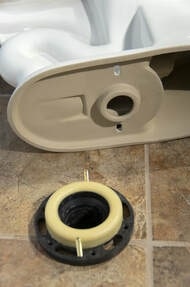Toilets are normally sealed to the drain pipe through a wax seal. The toilet needs a seal to protect primarily against sewer odors missing from entering the house. The work of that protective seal is also to not allow leaks in the connection of the toilet for the drain.

The change that the wax ring can be a complicated job, which requires cleaning the toilet, the flange, and the hands of the wax ring manipulation. However, there is a free wax alternative during the installation of the toilet.
To install a toilet with a wax neck, you must start by placing the bowl first and then the tank. Remember that you should avoid hitting or bearing excessive weight on the pieces of your ceramic or porcelain toilet, as they could break.
Instructions
1 . Scrape any wax from the toilet flange onto the remaining floor of a previous wax ring. Remove the bolts from the flange and examine the flange itself to make sure it is not broken. Clean the floor surface around the debris flange.
Fill a rag in the floor flange to keep sewer gases from entering the room, if there is going to be a lapse of time before installing the toilet. Slide the new flange bolts into the flange and align the screws so that they fit through the holes in the toilet base when the toilet is installed.
2 . Turn on the toilet bowl, or all toilet bowl and tank unit, upside down on a towel placed on the floor. Clean and dry the toilet horn, discharge outlet on the hygienic bottom, of any wax residue, if you had a wax ring on the toilet in the past. Peel the protective seal of the wax-free hygienic seal. Press the wax-free seal firmly onto the toilet horn, making sure all the adhesive is in contact with the toilet.
3. Remove the rag from the flange. Lift the toilet bowl or cup and tank unit and carefully lower it into place with the toilet seat alignment free of wax with the flange. Make sure the flange bolts pass through the holes in the base of the tank. You should feel a bit of resistance and “feel” the free seal of wax compress against the inside of the leak.
4 . Place the washers on the flange bolts and hand tighten the nut down on each bolt. Finish tightening the nuts with an adjustable wrench, making sure not to over tighten and crack the toilet. Place the bolt covers over the screws of the toilet base. Connect the water supply hose to the bottom of the stem of the toilet bowl fill valve, which sticks from the bottom of the tank. Open the water supply in the toilet and check around the toilet, including the base, for leaks. Install the toilet seat, if necessary, and place the lid on the tank.
What are the functions of the wax ring in a toilet?
A toilet is bolted to the floor, but what keeps sewer gas and water leaking down the toilet is the wax ring, which is about 1 inch thick and seals the bottom of the toilet bowl to the mounting flange on the drain on the floor of the toilet. The weight of the toilet compresses the wax and creates a seal against gas and water leaks. A replacement wax ring can be purchased for less than $5 starting April 2011 at hardware stores or home centers.
Sewer Gas
Sewer gas can be toxic and is caused by the decomposition of human waste. Sewer gas is present in almost all sewer systems and can enter the house due to a wax ring leaking. A defective wax ring at the base of the toilet bowl could allow sewer gas into the house and should be replaced immediately to avoid eye and throat irritation, suffocation and the risk of an explosion.
Water Damage
Water leaks around a defective wax ring may not be evident at first as water may leak from the seal very slowly at first. The wax ring should be suspected at the first sign of moisture around the base of the toilet to prevent the floor covering, subfloor and floor from framing water damage.
Other causes of leaks
There is no automatic assumption that the wax ring is the culprit just because moisture or moisture is seen or felt around the base of the toilet. The toilet tank may have condensation on its outer surface that may be flowing to the base of the toilet. The tank seals may be missing, as well as the connection to the bottom of the water supply tank. Make sure none of these items are to blame before replacing the wax ring.
Replacing Wax Rings
Turn off the water supply to the toilet by turning the shutoff valve at the base of the toilet bowl in a clockwise direction. Pull the chain, lift the toilet tank lid and set aside. Traces of water in the tank with a sponge and a bucket. Release the appropriate water supply hose from the bottom of the toilet tank with an adjustable faucet.
Pull up on the bolt caps at the base on each side of the toilet and set aside. Remove the nuts with an adjustable wrench. Grasp the bowl on each side and move back and forth to break the seal. Use a helper, and lift the container up and place it upside down. Placing a rag in the opening on the floor where the toilet was removed prevents sewer gas from entering the house. Scrape the remaining wax from the bottom of the toilet bowl and mounting flange on the floor, and press a new wax ring into place at the bottom of the toilet.
Remove the rag from the drain. Lifting the toilet up will help align the mounting holes with the fixing screws on the flange. Move the toilet from side to side slightly to seat the wax ring. Finish installing the toilet in the reverse order of removal.
The wax ring forms a seal between the toilet bowl and the drains on the floor. This wax seal prevents water leakage.
Considerations
Use a new wax ring whenever you replace a toilet. If there is a water leak in the bottom of the toilet bowl only when you pull the chain, a new wax ring may be necessary.
Warning
Connect the drain to the floor with a rag when the toilet bowl is out and you are not working on the wax ring. This will prevent the gas from entering the sewer.

